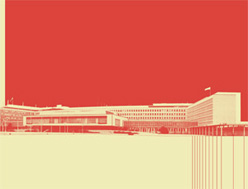Sabine Bitter & Helmut Weber
Autogestion, or Henri Lefebvre in New Belgrade
With contributions by Sabine Bitter & Helmut Weber, Ljiljana Blagojevic, Zoran Eric, Klaus Ronnberger, and Neil Smith
The artist book by Sabine Bitter and Helmut Weber is based on an unpublished orginal text by French philosopher and urbanist Henri Lefebvre which is printed as a facsimile. This central text is contextualized and interpretated by accompanying commentaries by Ljiljana Blagojevic, Zoran Eric, Klaus Ronnberger, and Neil Smith.
Neil Smith, Distinguished Professor, City University of New York and urban theorist, provides a short preface to the book.
Ljiljana Blagojevic, architectural historian from the Faculty of Architecture, Belgrade University, who discovered the Lefebvre text in the civic archives of Belgrade, contextualizes LefebvreÝs urban proposal through the urban history of the development of New Belgrade.
Zoran Eric, curator of the Museum of Modern Art in New Belgrade, focuses on the notions of self-management in the former Yugoslavia, which influenced Lefebvre.
Klaus Ronnberger, sociologist and urban theorist from Frankfurt, contextualizes LefebvreÝs theories regarding self-management in relation to the state in contemporary discourse.
The social and political contradictions between contemporary concepts of self-management and self-organisation, and LefevbreÝs idea of the autogestion arising out of the 1960s are read through the tension between the urban citizens who actualize these concepts and the state structures that regulate them.
The text from Henri Lefebvre was submitted as part of a proposal with French architects Serge Renaudie and Pierre Guilbaud for the International Competition for the New Belgrade Urban Structure Improvement in 1986, sponsored by the state of Yugoslavia.
In his urban vision for New Belgrade - the capital of former Yugoslavia founded in 1948 - Lefebvre emphasizes the processes and potentials of self-organization of the people of any urban territory to counter the failed concepts of urban planning from above. For Lefebvre, at this late point in his life, the promises of both modernist capitalist as well as state socialist architecture and city planning had failed.
Yet, Lefebvre viewed New Belgrade and Yugoslavia as having a particular position in what he has elsewhere called "the urban revolution". As Lefebvre states, "because of self-management, a place is sketched between the citizen and the citadin, and Yugoslavia is today [1986] perhaps one of the rare countries to be able to pose the problem of a New Urban."
Autogestion, or Henri Lefebvre in New Belgrade is available in five different editions of foldout poster covers (64.4 x 49.0 cm).
Edited by Sabine Bitter, Jeff Derksen, Helmut Weber
Published by Sternberg Press, Berlin and co-published with Fillip, Vancouver.
July 2009
English/French
18 x 25.5 cm, 160 pages,
9 b/w illustrations, softcover
ISBN 978-1-933128-77-1
$27.00 | ─19.00
Sternberg Press, Berlin, 2009
Fillip, Vancouver
Edition "Autogestion", 2009
Offset on paper / Photoprints on paper
Each 64.4 x 49.0 cm
"Because of Self-management, A Place is Sketched Between the Citizen and the Citadin..."
A series of five images functions as interchangeable covers for the book as well as a numbered artist edition. The photo collages for these covers and edition articulate the particular historical and recent situation of New Belgrade and the postulations of Lefebvre´s "Autogestion" and the "Right to the City".
#1: Sava Center, New Belgrade
#2: Palace of Federation, New Belgrade
#3: Apartment Block, New Belgrade
#4: Gazela, New Belgrade
#5: Peti Park, Belgrade
more information about the edition:
Grita Insam Gallery, Vienna
|



